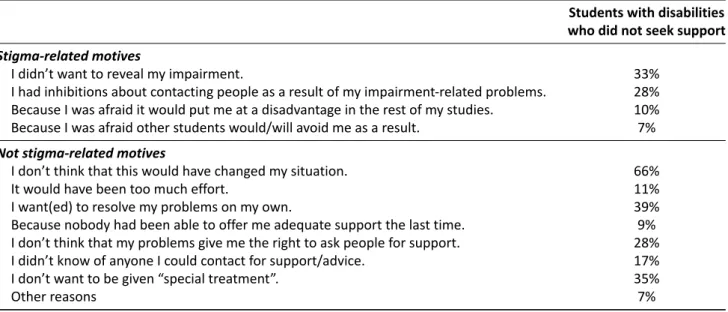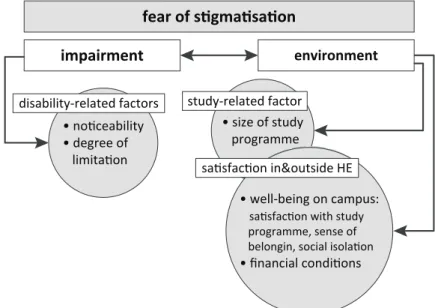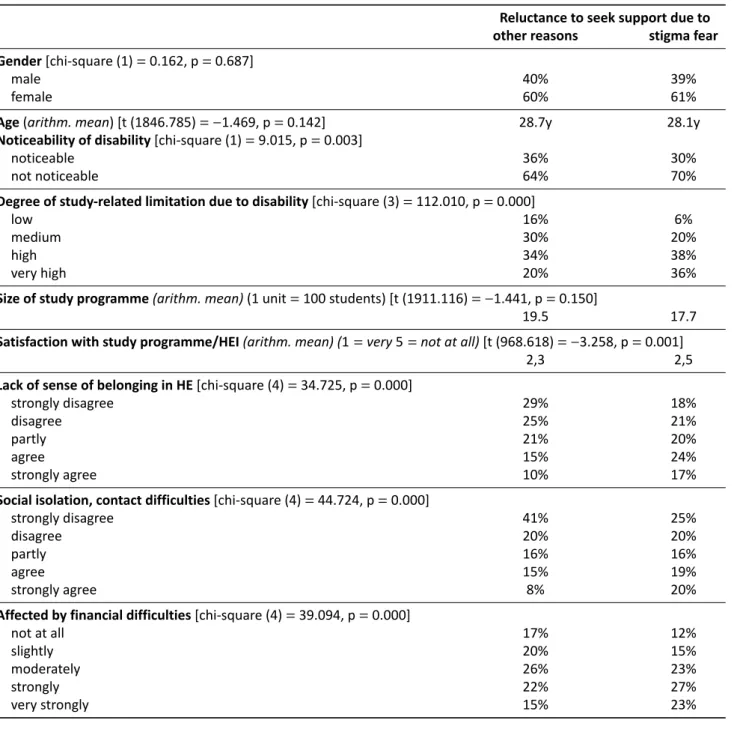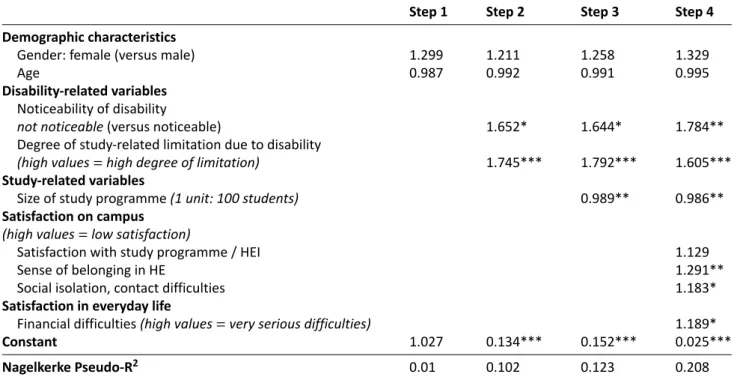• noceability
• degree of limitaon disability-related factors
environment fear of sgmasaon
impairment
• size of study programme study-related factor
sasfacon in&outside HE
• well-being on campus:
sasfacon with study
programme, sense of
belongin, social isolaon
• financial condions
Figure 1. Determinants of fear of stigmatisation associated with the reluctance to seek help.
in step 3. This predictor is used as a proxy for the feel- ing of anonymity on campus, assuming that study pro- grammes with large numbers of students are associated with a greater feeling of anonymity. When developing the model, we tested different study-related character- istics, e.g., type of HEI or field of study, but they were excluded due to non-significant results or an insufficient number of cases required for the proper performance of a regression analysis.
Finally, we assume that positive environmental con- ditions for studying have a beneficial effect, i.e., reduce the reluctance to seek help due to fear of stigmatisa- tion. This last step of our model takes the following vari- ables related to well-being on campus or in everyday life into account:
• The predictor satisfaction with study programme and HEI is a weighted index of four items: degree of identification with and recommendation of the study programme, fulfilment of expectations and overall satisfaction at the university. The index was built by applying a principal component analysis (revealing a single dimension) and using the factor loadings as weights;
• A sense of belonging at the university was mea- sured using a five-point Likert scale (1 = strongly disagree to 5 = strongly agree);
• A feeling of social isolation at the university was measured using a five-point Likert scale (1 = strongly disagree to 5 = strongly agree);
• Financial difficulties were measured using a five- point Likert scale (1 = “not at all” to 5 = “very strongly”) indicating to what extent students were facing financial difficulties at the time of the survey.
4. Results
Table 2 presents descriptive statistics regarding the mo- tives that explained students’ reluctance to seek support.
Even though there are no significant gender or age differ- ences between the two groups, students who are reluc- tant to seek help due to fear of stigmatisation are more likely to have severe disability-related limitations or a non-apparent disability. Three quarters report a (very) high degree of study-related limitations due to disabil- ity while this applies to half of the students with other- wise (not stigma-)motivated reluctance to help seeking.
Furthermore, all variables regarding environmental fac- tors differ significantly between the two groups: students who do not seek support due to fear of stigmatisation are less satisfied with their study programme/HEI, lack a sense of belonging or indicate social isolation. Moreover, they are significantly more likely to be affected by finan- cial difficulties.
In a logistic regression, the dependent variable fear of stigma (yes or no) was regressed on a number of pre- dictors. The values of the regression coefficients (𝛽x) de- termine the direction of the relationship:
Y = 𝛽
0+ 𝛽
1∗ gender + 𝛽
2∗ age + 𝛽
3∗ noticeability +
+ 𝛽
4∗ limitation + 𝛽
5∗ size + 𝛽
6∗ satisfaction +
+ 𝛽
7
∗ belonging + 𝛽
8
∗ isolation + 𝛽
9
∗ financial
Table 3 presents the odds ratios (Exp(𝛽)): values above
one indicate that higher values of the explanatory vari-
able increase the predicted probability of the first (not
seek assistance due to the fear of stigmatisation) rela-
tive to the second outcome (not seek assistance due to
other, not stigma-related reasons). Coefficients less than
one indicate the opposite. Thus, the ratio of 1,745 for the
degree of limitation in the second step of the model indi-
cates that the odds of not seeking assistance due to fear



